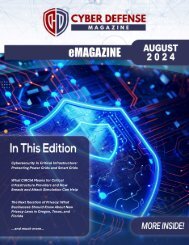Cyber Defense eMagazine June 2020 Edition
Cyber Defense eMagazine June Edition for 2020 #CDM #CYBERDEFENSEMAG @CyberDefenseMag by @Miliefsky a world-renowned cyber security expert and the Publisher of Cyber Defense Magazine as part of the Cyber Defense Media Group as well as Yan Ross, US Editor-in-Chief, Pieruligi Paganini, Co-founder & International Editor-in-Chief, Stevin Miliefsky, President and many more writers, partners and supporters who make this an awesome publication! Thank you all and to our readers! OSINT ROCKS! #CDM #CDMG #OSINT #CYBERSECURITY #INFOSEC #BEST #PRACTICES #TIPS #TECHNIQUES
Cyber Defense eMagazine June Edition for 2020 #CDM #CYBERDEFENSEMAG @CyberDefenseMag by @Miliefsky a world-renowned cyber security expert and the Publisher of Cyber Defense Magazine as part of the Cyber Defense Media Group as well as Yan Ross, US Editor-in-Chief, Pieruligi Paganini, Co-founder & International Editor-in-Chief, Stevin Miliefsky, President and many more writers, partners and supporters who make this an awesome publication! Thank you all and to our readers! OSINT ROCKS! #CDM #CDMG #OSINT #CYBERSECURITY #INFOSEC #BEST #PRACTICES #TIPS #TECHNIQUES
You also want an ePaper? Increase the reach of your titles
YUMPU automatically turns print PDFs into web optimized ePapers that Google loves.
• The risk that critical information becomes unavailable<br />
• The risk that critical information is changed without authorization<br />
Associated with risk is cost. Security incidents cost money. So does preventing them. The cost, for<br />
example, of a computer virus is the loss in productivity of an organization’s personnel plus the time and<br />
expense for IT personnel to remove the virus and restore availability. The cost of a theft of a trade secret<br />
by a cyber-thief is the value of the trade secret. Implementing security also has costs. Firewalls and other<br />
security technology take capital away from other uses. Information security personnel come at the<br />
expense of personnel who can directly more contribute to the bottom line. And every hour management<br />
spends in a security meeting, or personnel spend on security awareness training, is an hour that could<br />
otherwise also contribute to the bottom line.<br />
Requirements for an Information Security Management Program<br />
The drivers behind an organization’s information security management program are the evolving<br />
landscape of laws, regulations, and competition, as well as evolving information security “best effective”<br />
practices. Organizations that hold personal, financial or health information of others are required to<br />
adhere to various federal and state laws and regulations. These include<br />
• HIPAA (electronic protected health information)<br />
• Sarbanes-Oxley<br />
• GDPR – General Data Protection Regulation<br />
Organizations may also have various contractual requirements for information or data security. Credit<br />
card processors, for example, must conform to the Payment Card Industry Data Security Standard.<br />
As organizations come to more deeply understand the competitive value of the information stored in their<br />
computer networks and the need to make that information securely available anytime and anywhere,<br />
they discern the need for a formal information security management program to assure that information<br />
is kept confidential, available, and correct.<br />
As organizations have increasing needs to share information with suppliers, customers, and other<br />
business relations they are increasingly becoming concerned with the information security capabilities of<br />
these third parties.<br />
An organization’s information security management program must be built upon current and emerging<br />
information security “effective best-practices.” As the information security industry has evolved, the<br />
industry has tended to settle on three distinct models as to what constitutes a set of “effective bestpractices”<br />
for managing the security of information:<br />
• ISO-27001 Specification for an Information Security Management System<br />
• ISO-27002: Code of Practice for Information Security Management<br />
<strong>Cyber</strong> <strong>Defense</strong> <strong>eMagazine</strong> –<strong>June</strong> <strong>2020</strong> <strong>Edition</strong> 43<br />
Copyright © <strong>2020</strong>, <strong>Cyber</strong> <strong>Defense</strong> Magazine. All rights reserved worldwide.


















